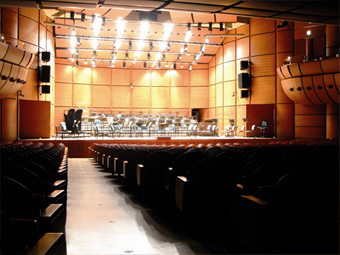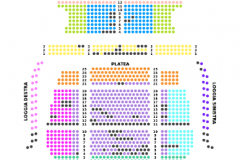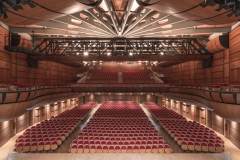Borodin and Prokofev
Mo | Tu | We | Th | Fr | Sa | Su |
When Ugo Fantozzi and his colleagues are forced to watch Battleship Potemkin in its original language, interrupting the viewing of the Italian national team’s World Cup match, the result is tragicomic, culminating in Fantozzi's iconic, profane (and liberating) outburst, which is not exactly complimentary toward Ėjzenštejn’s legendary film.
We believe the reaction would have been different if they had listened to Dmitri Shostakovich's Symphony No. 11 in G minor, a musical representation of the massacre of workers gathered in front of the Winter Palace in Saint Petersburg by Tsar Nicholas II's cavalry. In a re-edited version in Italy in 1976, this symphony was part of the film's soundtrack: in the famous scene of the soldiers advancing toward the crowd on the Odessa steps, we can hear the second movement of the Eleventh Symphony in the background.
Despite the general tone, the Symphony is perhaps one of the most emotionally powerful works in Shostakovich's production. Hearing it performed by the Milan Symphony Orchestra is certainly worth missing a national football match, without a doubt.
Program and cast
Duration: approx. 80'
Aleksandr Borodin:
Polovtsian Dances from Prince Igor
Sergei Prokofiev:
Romeo and Juliet, Suite
Milan Symphony Orchestra and Symphony Choir
Massimo Fiocchi Malaspina: Choir Conductor
Emmanuel Tjeknavorian: Conductor
Auditorium di Milano Fondazione Cariplo
 The Auditorium of Milan was opened on 6 October 1999. It houses the Symphony Orchestra and Symphonic Chorus of Milan Giuseppe Verdi. The inauguration Riccardo Chailly led the orchestra performing the Symphony no. 2 of Gustav Mahler .
The Auditorium of Milan was opened on 6 October 1999. It houses the Symphony Orchestra and Symphonic Chorus of Milan Giuseppe Verdi. The inauguration Riccardo Chailly led the orchestra performing the Symphony no. 2 of Gustav Mahler .
The Auditorium is owned by the Auditorium di Milano Fondazione Cariplo srl .
The activity of the Symphonic Orchestra and Symphonic Choir of Milan Giuseppe Verdi is promoted and supported by the Foundation Symphony Orchestra and Symphonic Chorus Giuseppe Verdi of Milan , founded in April 2002 and succeeded the Association Orchestra Sinfonica di Milano Giuseppe Verdi , consisting of 12 October 1992.
The auditorium hosts the concert season of the Verdi Orchestra , an amateur orchestra ( laVerdi for all), cultural events , concerts and lectures for schools.
In 1920, depending on the corner of Via Torricelli and street Conchetta the great cineteatro the Montagnetta with 2000 seats in the stalls and gallery.
In 1932, the film becomes Montagnetta cinema Gotthard , by the course of the same name and is run by Jordan Rota.
In 1933, the management company switches to Cinetea - Negri & C. restructuring the hall, the seats are reduced to 1700 .
Around 1937 the hall was renovated designed by the architect . Alessandro Rimini and takes the name of Massimo cinema . The restaurant opens Oct. 20, 1938 .
During the Second World War, cinema Massimo is damaged by bombing the hall closes but reopens in the spring of 1945 already in the autumn of the same year .
From the first half of the seventies, Massimo is also used as a theater and concert venue .
The difficulty of managing a hall so large that it can not have major films cinema Maximum lead to the closure in 1979. Subsequently the room is rented by the group Bargawam that uses it for a few years as a recording studio for television programs.
After a period of neglect is acquired by the entrepreneur who decides to transform Agostino Luini after appropriate renovations by Studio Marzorati , in the Auditorium of Milan , which opened October 6, 1999 the Mayor Albertini, who subsequently renamed the open space in front with the name of Largo Gustav Mahler November 28, 2001 .
The hall has been designed as a multipurpose for different activities : concerts of symphonic, choral and chamber music , jazz and pop music , sound recordings with digital techniques , diffusion of the shows through satellite TV and films on the big screen.
You can easily reach the Auditorium in Milano by these means:
TRAM
3.it stops before the Auditorium
9, 29 e 30 P. le XXIV Maggio stop
15 Castelbarco/Giambologna stop
BUS
59 / 71 they stop before the Auditorium
TROLLEYBUS
90 e 91 Tibaldi/Meda stop
SUBWAY
Line 1 Duomo stop + tram 3
Line 2 P. ta Genova stop + bus 59
Line 2 Romolo stop + trolleybus 90 and 91
Line 2 Famagosta stop + bus 59
Line 3 Duomo stop + tram 3
TAXI
Via Torricelli parking
PARKINGS
Romolo (close to the subway line 2) open from Monday to Sunday from 7 a.m. to 8 p.m.
Famagosta ( close to the subway line 2) open everyday from 7 a.m. to 1.00 a.m

 EN
EN DE
DE IT
IT FR
FR ES
ES RU
RU JP
JP RO
RO
 Seating plan
Seating plan 